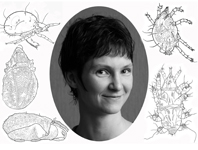Abstract
Two new species of oribatid mites of the subgenus Galumnella (Galumnella) (Acari: Oribatida: Galumnellidae) are described from soil and litter of forest zones of China. Galumnella (G.) nonporosa sp. nov. differs from Galumnella (G.) nipponica by the falciform bothridial setae and obvious reticulate pattern in the anogenital region. Galumnella (G.) sidorchukae sp. nov. differs from Galumnella (G.) cellularis by the laciniate bothridial setae and by the absence of postanal porose area. Morphological additions to the description of Galumnella (G.) parageographica are presented based on Chinese specimens, which is recorded in China for the first time.
References
Aoki, J. & Hu, S.H. (1993) Oribatid mites from tropical forests of Yunnan Province in China. II. Families Galumnidae and Galumnellidae. Zoological Science, 10(5), 835−848.
Balogh, J. (1960) Oribates (Acari) nouveaux d’Angola et du Congo Belge (2ème série). Companhia de Diamantes de Angola, Lisboa, 51, 15–40.
Balogh, J. & Balogh, P. (2002) Identification keys to the oribatid mites of the Extra-Holarctic regions. Vol. 1. Miskolc, Well-Press Publishing Limited, 453 pp.
Balogh, J. & Mahunka, S. (1967) New Oribatids (Acari) from Vietnam. Acta Zoologica Academiae Scientiarum Hungaricae, 13 (1–2), 39–74.
Berlese, A. (1916) Centuria prima di Acari nuovi. Redia, 12, 19–67.
Ermilov, S.G. & Anichkin, A.E. (2011) New oribatid mites of the genera Pergalumna and Galumnella (Acari, Oribatida, Galumnoidea) from Vietnam. Acarina, 19 (2), 242–251.
Ermilov, S.G. & Kalúz, S. (2013) Two new species of the family Galumnellidae (Acari: Oribatida) from India. Acarologia, 53 (3), 315–321.
Ermilov, S.G. & Khaustov, A.A. (2019) New Galumnoidea (Acari, Oribatida) from 283 Tanzania. Zootaxa 4545 (4), 531–547.
https://doi.org/10.11646/zootaxa.4545.4.5
Ermilov, S.G. & Klimov, P. (2017) Generic revision of the large-winged mite superfamily Galumnoidea (Acari, Oribatida) of the world. Zootaxa, 4357 (1), 1–72.
https://doi.org/10.11646/zootaxa.4357.1.1
Norton, R.A. & Behan-Pelletier, V.M. (2009) Oribatida. Chapter 15. In: G.W. Krantz and D.E. Walter (eds.). A Manual of Acarology. Texas Tech University Press, Lubbock, pp. 430–564.
Subías, L.S. (2004) Listado sistemático, sinonímico y biogeográfico de los ácaros oribátidos (Acariformes: Oribatida) del mundo (excepto fósiles). Graellsia, 60 (número extraordinario), 3–305. Online version accessed in January 2019, 478 pp.
Available from: http://escalera.bio.ucm.es/usuarios/bba/cont/docs/RO_1.pdf (Accessed 24 Jul. 2019)Suzuki, K. & Aoki, J. (1970) A new species of oribatid mite, Galumnella nipponica, from central Japan (Acari: Cryptostigmata). Annotationes Zoologicae Japonenses, 43 (3), 166–169.
Zhang, Z.Q. (2018) Repositories for mite and tick specimens: acronyms and their nomenclature. Systematic & Applied Acarology, 23 (12), 2432–2446.
http://doi.org/10.11158/saa.23.12.12

